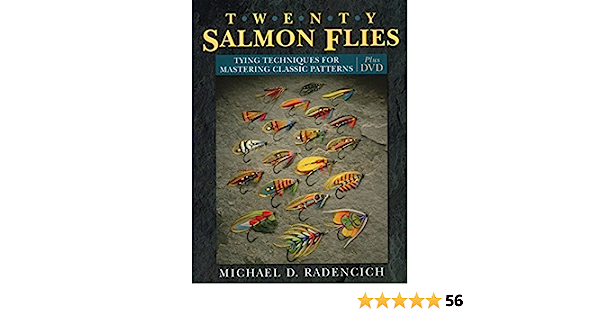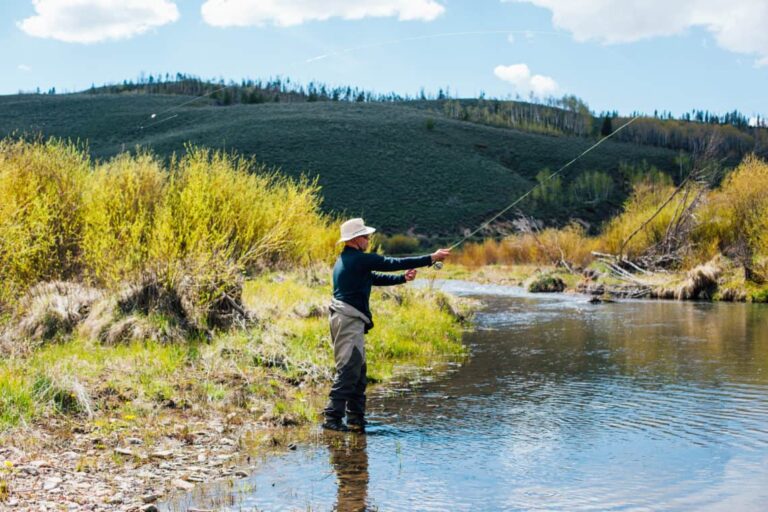Fly fishing is indeed better for trout due to its ability to accurately mimic natural prey and match the feeding patterns of trout. Fly fishing involves using lightweight flies that float on the water’s surface or sink just below it, imitating insects, larvae, or other small creatures that trout feed on.
This method allows anglers to present the fly in a realistic manner, enticing trout to strike. Additionally, the casting techniques used in fly fishing provide more control and precision, essential for targeting trout in various water conditions and environments. Introducing yourself to the world of fly fishing can be an exciting and rewarding experience, especially if you enjoy trout fishing.
As one of the most popular types of fishing, fly fishing offers a unique approach to catching trout that differs from traditional spin fishing methods. By utilizing special lightweight flies and distinctive casting techniques, fly fishing allows anglers to strategically present the fly to mimic the natural prey of trout, increasing the chances of attracting strikes. We will explore the reasons why fly fishing is considered better for trout, its advantages over other fishing methods, and essential tips to enhance your fly fishing skills for a successful trout fishing experience.

Credit: www.flyfisherman.com
The Art Of Fly Fishing For Trout
Fly fishing is an ancient and elegant practice that offers a unique approach to catching trout. It involves the use of artificial flies as bait, which adds an element of finesse and skill to the experience. In this section, we will explore the basics of fly fishing, the benefits of using flies as bait, and how this technique enhances the overall trout fishing experience.
Understanding The Basics Of Fly Fishing:
- Fly fishing is a specialized angling method that relies on casting a lightweight fly onto the water’s surface to imitate the insects and other prey that trout feed on.
- Unlike traditional fishing, which involves casting a heavy lure, fly fishing requires a more delicate touch and finesse.
- The technique involves using a specific type of fishing rod, called a fly rod, with a weighted line and a colorful fly attached to it.
- It is essential to learn the art of casting, which involves a smooth and controlled movement to create a lifelike presentation of the fly.
The Unique Approach To Catching Trout:
- Fly fishing offers a more challenging and rewarding experience compared to other fishing methods.
- The lightweight flies used in fly fishing require the angler to rely on their casting skills to accurately present the fly to the trout.
- This element of challenge adds excitement and satisfaction when successfully fooling a trout into taking the fly.
- Fly fishing allows anglers to connect with the natural environment, appreciating the beauty of the surroundings while being fully immersed in the fishing experience.
The Benefits Of Using Flies As Bait:
- Flies used in fly fishing imitate various insects, such as mayflies, caddisflies, and beetles, which are common prey for trout.
- The use of flies as bait provides a more natural and realistic presentation compared to traditional fishing lures.
- Flies can be tied in various shapes, sizes, and colors, giving anglers the opportunity to match the hatch and mimic the insects that trout are actively feeding on.
- The versatility of flies allows anglers to experiment with different patterns and techniques to increase their chances of triggering a trout’s predatory instincts.
How Fly Fishing Enhances The Overall Experience:
- Fly fishing is not just about catching trout; it is a holistic experience that engages all the senses.
- The rhythmic motion of casting, the sound of the line whistling through the air, and the anticipation of a strike create a sense of tranquility and excitement.
- This method encourages a more intimate connection with the water, requiring anglers to read the currents and understand trout behavior for successful fishing.
- Fly fishing promotes catch and release practices, preserving trout populations and ensuring sustainable fishing for future generations.
Fly fishing for trout is an art that combines skill, technique, and appreciation for the natural world. Understanding the basics of fly fishing, utilizing flies as bait, and experiencing the unique approach it offers are just some of the reasons why fly fishing is a favorite among anglers.
So, grab your fly rod, tie on a colorful fly, and embark on a fly fishing adventure that will not only challenge you but also provide a deeper connection with nature and the elusive trout.
The Advantages Of Fly Fishing For Trout
Fly fishing is often considered the ultimate method for pursuing trout. This angling technique has several advantages that make it particularly effective in targeting trout and increasing the chances of a successful catch. If you’re wondering why so many anglers swear by fly fishing for trout, let’s explore some of the key advantages below.
Increased Accuracy And Precision In Casting
- With fly fishing, anglers have better control over their casts, allowing for increased accuracy and precision.
- The use of lightweight flies and specialized equipment enables anglers to target specific areas where trout are likely to be hiding.
- This increased control and precision in casting helps minimize spooking trout and increases the chances of a successful presentation.
Achieving A More Natural Presentation
- One of the most significant advantages of fly fishing for trout is the ability to achieve a more natural presentation.
- The lightweight flies used in fly fishing mimic the insects and other prey that trout feed on. This makes the presentation more enticing and realistic, increasing the likelihood of a strike.
- The delicate nature of fly fishing allows for subtle and lifelike movements that can be irresistible to trout, making it a highly effective method for fooling them into biting.
Targeting Specific Areas Where Trout Thrive
- Fly fishing gives anglers the advantage of being able to target specific areas where trout are most likely to be found.
- Whether it’s casting to a riffle, a deep pool, or a trout’s preferred feeding lane, fly fishing allows for precise targeting, maximizing the chances of a hookup.
- By presenting the fly right in the trout’s strike zone, fly anglers can capitalize on their knowledge of trout behavior and habitat.
The Effectiveness Of Fly Patterns In Attracting Trout
- Fly fishing offers a wide range of fly patterns that are highly effective in attracting trout.
- Flies can imitate various stages of insect life cycles, such as nymphs, emergers, and dry flies, ensuring that there’s a suitable option for any given situation.
- Different fly patterns can be selected based on the specific insects hatching at a particular time and place, increasing the chances of enticing trout to take the bait.
So, if you’re looking to up your trout fishing game, it’s clear that fly fishing offers significant advantages. The increased accuracy and precision in casting, the ability to achieve a more natural presentation, the targeted approach, and the effectiveness of fly patterns all contribute to making fly fishing an excellent choice for trout enthusiasts.
Give it a try, and you may find yourself hooked on the art of fly fishing!
Expert Tips And Techniques For Fly Fishing Trout
Selecting The Right Equipment For Successful Fly Fishing
Choosing the right equipment is essential for a successful fly fishing experience. Here are some key points to consider:
- Fly rod: Opt for a fly rod that is specifically designed for trout fishing. The weight and length of the rod will depend on the type of water you plan to fish in and the size of trout you are targeting.
- Fly reel: Look for a reel that is lightweight, durable, and has a smooth drag system. Balance the reel with the weight of your rod for optimum performance.
- Fly line: Ensure that you select the appropriate weight of fly line based on the rod and fishing conditions. A floating line is ideal for most trout fishing scenarios.
- Leaders and tippets: Choose leaders and tippets that match the weight of your fly line. Thinner tippets are more stealthy and less likely to spook the trout.
- Flies: Have a variety of flies in your tackle box to match the trout’s diet and the prevailing conditions. Dry flies, nymphs, and streamers are commonly used for trout fishing.
Mastering Different Casting Techniques
To effectively target trout with your fly fishing technique, it’s important to master various casting techniques. Consider the following tips:
- The basic cast: Start with the basic overhead cast. Keep your wrist firm and focus on a smooth acceleration and abrupt stop at the end of the cast. Practice your timing and control.
- Roll cast: The roll cast is ideal for fishing in tight spaces or when there’s limited backcast room. Master this technique to quickly present your fly to trout lurking near the bank or under overhanging branches.
- Reach cast: The reach cast helps you get a drag-free presentation by extending your fly’s drift. After the forward cast, extend your reach with a gentle twist of the wrist, allowing your fly to land slightly upstream of the target area.
- Roll mend: When fishing in flowing water, the roll mend technique is crucial for maintaining a natural drift. By making a mend upstream of the fly, you can reduce drag and enhance your chances of enticing a strike.
Identifying Prime Trout Habitats
Trout tend to favor specific habitats that offer ample food and cover. Consider the following traits when identifying prime trout habitats:
- Cold, oxygenated water: Trout thrive in cold, well-oxygenated waters. Look for areas with strong currents, riffles, or deeper pools where oxygen levels are higher.
- Undercut banks: Trout often seek refuge under undercut banks, which provide cover from predators and a steady supply of food. Target these areas with accurate casts.
- Submerged structures: Fallen trees, boulders, and submerged vegetation create ideal hiding spots for trout. These structures offer protection and serve as ambush points.
- Overhanging vegetation: Trout are attracted to areas with overhanging vegetation, as it provides shade and helps conceal them from predators.
- Gravel beds: Trout use gravel beds for spawning, so these areas are often teeming with fish during the appropriate season.
Understanding Trout Behavior And Feeding Patterns
To consistently catch trout, it’s crucial to understand their behavior and feeding patterns. Consider the following insights:
- Feeding zones: Trout tend to inhabit different depths depending on their feeding behavior. They will often be found near the surface for opportunistic feeding or in deeper water when selectively feeding on specific prey.
- Ambush points: Trout are ambush predators and will position themselves strategically to capture their prey. Look for areas with rocks, submerged structures, or sudden depth changes where trout can lie in wait.
- Temperature preferences: Trout prefer water temperatures between 50°f and 65°f. They may be more active during cooler times of the day or seek deeper, cooler water during hot summer months.
- Seasonal variations: Different seasons bring changes in trout behavior and feeding preferences. Adapt your techniques and fly selection accordingly to match their shifting dietary needs.
Matching Flies To The Trout’S Diet
Matching your fly patterns to the trout’s natural diet is crucial for success. Consider the following tips:
- Observe the environment: Take note of the insects and other small organisms present in the trout’s habitat. Look for hatching insects, falling terrestrials, or indications of what the trout may be feeding on.
- Use imitative flies: Select flies that closely resemble the size, shape, and color of the insects or baitfish present in the trout’s habitat. Imitative flies are more likely to elicit strikes.
- Consider different life stages: Insects go through various life stages, from nymphs to emergers to adults. Have a range of fly patterns to cover each stage.
- Be flexible: If the trout aren’t responding to your chosen fly pattern, be prepared to switch things up. Carry a variety of flies to experiment with until you find the one that triggers a response.
Navigating Different Water Conditions For Optimal Results
Trout can be found in a variety of water conditions, and adapting your approach accordingly can lead to better results. Consider the following strategies:
- Calm waters: In calm water, trout are more cautious and easily spooked. Approach with stealth, make accurate casts, and use longer leaders and tippets for a more natural presentation.
- Fast-flowing waters: Fast-flowing rivers or streams require quick mends and strong line control. Use heavier flies or split-shot weights to get your fly down to the trout’s level.
- Still waters: Lakes and ponds require different tactics. Look for drop-offs, weed beds, or other structure where trout may be lurking. Use slow retrieves or varied retrieves to entice strikes.
- Murky waters: In turbid or muddy waters, trout rely more on their sense of vibration and smell. Use larger, more visible flies or ones with scent attractants to increase your chances of success.
Remember, practice makes perfect when it comes to fly fishing. Keep honing your skills, observing trout behavior, and experimenting with different techniques to become a true expert in the art of fly fishing for trout.
Conclusion
After exploring the benefits of fly fishing for trout, it is clear that this method offers numerous advantages for anglers. The delicate presentation of the fly, coupled with the opportunity for precise control and manipulation, makes it an enticing option.
Fly fishing allows for a more immersive and strategic fishing experience. The ability to match the hatch and mimic natural insect behavior increases the chances of success. Additionally, the emphasis on catch and release in fly fishing promotes conservation efforts, ensuring the sustainability of trout populations for future generations.
While spin fishing still has its merits, fly fishing offers a unique and rewarding approach to targeting trout. So, whether you’re a seasoned angler or just starting out, consider giving fly fishing a try – it might just become your new favorite way to fish for trout.
Happy fishing!






